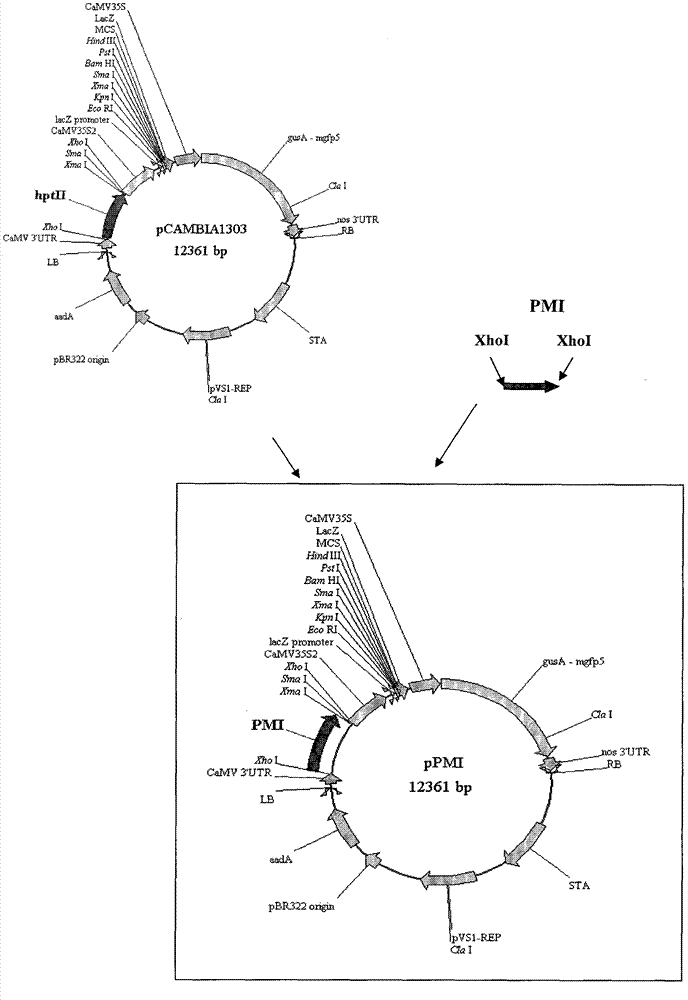Method for constructing transgenic Arabidopsis plant by phosphomannose-isomerase (PMI) gene of yeast
A technology of mannose isomerase and Arabidopsis thaliana, applied in botany equipment and methods, biochemical equipment and methods, plant products, etc., to achieve the effect of human and environmental safety
- Summary
- Abstract
- Description
- Claims
- Application Information
AI Technical Summary
Problems solved by technology
Method used
Image
Examples
Embodiment 1
[0035]Preparation of Agrobacterium EHA105 Containing Plasmid pPMI of Yeast PMI Gene
[0036] The transformation vector (or transformation plasmid) containing the PMI gene constructed by the applicant is pPMI, which is transformed from the plasmid pCAMBIA1303, and the hygromycin resistance in the original plasmid pCAMBIA1303 is replaced by the PMI gene cloned from Saccharomyces cerevisiae Genes, in addition to the PMI gene in the left and right borders, the gene itself contains the GUS-GFP fusion protein gene. The construction flowchart of the transformation plasmid pPMI in this embodiment is shown in figure 2 .
[0037] Four days before dipping, Agrobacterium tumefaciens strain EHA105 was taken out from -70°C, streaked on LB solid medium, and cultured at 28°C for two days. Amplify the described PMI gene with following primer pair (underline is restriction site), and the nucleotide sequence of used primer pair is as follows:
[0038] upstream primer P 1 : 5′GC CTCGAG CCA...
Embodiment 2
[0041] Embodiment 2 material source and acceptor preparation
[0042] The Arabidopsis thaliana number CS3081 (species name: Nossen) in this example was donated by the Arabidopsis Biological Resource Center (Arabidopsis Biological Resource Center). Put the seeds into a 1.5mL centrifuge tube, add a small amount of water to moisten them, and put them in a refrigerator at 4°C for vernalization for 3 days. First soak the seeds with 75% alcohol for 5-10 minutes, and keep inverting to mix them evenly, and then rinse them with sterile water for 5 times. For transformation, sterile seeds were first sown on sterile filter paper and cultured at 23° C. for 16 hours under long-day light. 2-3 days after the seeds germinate, transplant the seedlings into the Hoaglund nutrient solution (see Table 1 for the ingredients). The specific steps are: first add 2.5L of the Hoaglund nutrient solution , and then punch six holes with a diameter of about 1 to 1.5 cm on a plastic foam board that is simi...
Embodiment 3
[0046] Genetic Transformation of Arabidopsis
[0047] Arabidopsis plants were transformed by the usual inflorescence dipping method (Clough and Bent, 1998). The main steps are as follows: Pick a single colony of Agrobacterium on the LB plate, inoculate it into 10 mL of LB culture solution, and culture it at 28° C. and 200 rpm for 18 to 24 hours. Inoculate 1.5 L of fresh LB culture solution with the culture at a volume ratio of 1:100, and shake the bacteria overnight at 200 rpm at 28°C. Collect the bacteria at 8000rpm for 5min, resuspend in the inorganic salt component containing 1 / 2MS basic medium, add 50g / L sucrose, 2X10 -3 In the liquid solution of g / L Silwet-77, adjust the OD600 value to about 0.8. Pour the liquid infusion into the culture pot, then turn the Arabidopsis upside down, and let the inflorescence soak in the liquid for 10-30S. After dipping, blot the excess water on the plants with toilet paper, put them back into the cultivation room at a temperature between...
PUM
 Login to View More
Login to View More Abstract
Description
Claims
Application Information
 Login to View More
Login to View More - R&D Engineer
- R&D Manager
- IP Professional
- Industry Leading Data Capabilities
- Powerful AI technology
- Patent DNA Extraction
Browse by: Latest US Patents, China's latest patents, Technical Efficacy Thesaurus, Application Domain, Technology Topic, Popular Technical Reports.
© 2024 PatSnap. All rights reserved.Legal|Privacy policy|Modern Slavery Act Transparency Statement|Sitemap|About US| Contact US: help@patsnap.com










